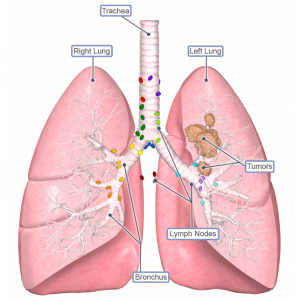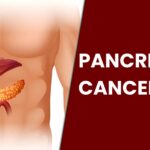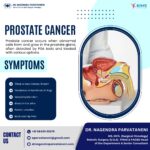Lung cancer is one of the most commonly diagnosed cancers. It develops when abnormalities occur in either the lungs or the bronchi (the air tubes leading to the lungs).
People who smoke tend to be at greater risk for the disease, and studies have shown that female smokers may be more likely to develop lung cancer than male smokers. But lung cancer can also occur in people who have never smoked.

You may not notice any symptoms of lung cancer ― many people don’t. Often the first sign of the disease is an abnormal spot that appears on a chest x-ray or a CT scan for another medical condition.
It’s possible you may experience one or more of the following symptoms:
- coughing
- shortness of breath
- chest pain
- loss of appetite
- coughing up phlegm, mucus, or blood
- fatigue
Many other conditions can cause these issues. If you have symptoms like these, talk with your doctor to help you figure out what’s causing them.
There are two main types of lung cancer, non-small cell lung cancer and small cell lung cancer. Non-small cell lung cancer is more common.
- Non-Small Cell Lung Cancer (NCSLC)
Find out about Adenocarcinoma and squamous cell carcinoma, which are the two most common subtypes of non-small cell lung cancer (NSCLC).
- Small Cell Lung Cancer (SCLC)
Accounting for around 13 percent of lung cancers, small cell lung cancer (SCLC) begins in the cells surrounding the bronchi. Learn more about this less common type.
- Pulmonary Neuroendocrine Tumors
Learn about neuroendocrine tumors, a highly diverse group of tumors formed by neuroendocrine cells.
Non-small cell lung cancer is the most common type of lung cancer and is usually treated with surgery. This form of the disease begins when the cells that make up the lining of the lungs, called epithelial cells, become abnormal and start to grow uncontrollably, forming a mass called a tumor.
3 Types of Non-Small Cell Lung Cancer
Adenocarcinoma begins in the cells that line the alveoli (tiny air sacs in the lungs where the exchange of oxygen and carbon dioxide takes place).
Squamous cell carcinoma begins in the cells that line the bronchial tubes in the center of the lungs.
Large cell carcinoma, also called undifferentiated lung cancer, is the name given to about 5 percent of non-small cell lung cancers that do not belong to either of the first two types.
Non-small cell lung cancer tumors can be put into further subcategories based on specific genetic mutations that can take place in cancer cells. Our doctors can identify these mutations during your diagnostic testing and use this information to determine what treatments might be most effective for you. Learn more about how we use personalized medicine to guide treatment decisions.
Small Cell Lung Cancer (SCLC)
Small cell lung cancer begins when the cells surrounding the bronchi (the air tubes that lead from the trachea, or windpipe, to the lungs), called neuroendocrine cells, become abnormal and start to grow uncontrollably, forming a mass called a tumor.
Small cell lung cancer is less common than non-small cell lung cancer. Small cell lung cancer accounts for about 13 percent of all lung cancer cases per year in the United States ― approximately 30,000. It develops in equal numbers among men and women.
Small cell lung cancer tends to spread quickly to other parts of the body and to the lymph nodes in the chest, which filter foreign particles out of the body. This means that when the cancer is found, it has often already begun to spread.
Pulmonary Neuroendocrine Tumors
Neuroendocrine cells help heal the thin layer of tissue — known as the epithelium — that lines internal organs and other surfaces inside the body after injury, including injury from infection. Occasionally, however, neuroendocrine cells become overactive and, eventually, may become cancerous.
A small percentage of all lung cancers are neuroendocrine tumors. Because neuroendocrine cells are found throughout the body, neuroendocrine tumors can arise in a variety of organs, not just in the lungs. In fact, the vast majority of the time, they occur in the gastrointestinal system. For more information about neuroendocrine tumors in the gastrointestinal system, please visit the Gastrointestinal Neuroendocrine Tumors section of our website.
Doctors may diagnose and treat neuroendocrine tumors according to the types of cells involved, how the tumor cells look under the microscope, and where they are in the body.
Types of Pulmonary Neuroendocrine Tumors
There are several types of neuroendocrine tumors that can arise in the lungs.
Pulmonary Carcinoid Tumors
Up to 25 percent of all carcinoid tumors are found in the lungs. The majority of these tumors develop in the major bronchi (large tubes that lead air from the windpipe into the lungs). There is no direct evidence that smoking causes pulmonary carcinoid tumors, yet studies suggest that a higher percentage of patients with atypical pulmonary carcinoid tumors smoke.
Pulmonary carcinoid tumors are further classified as follows:
Typical Carcinoid Tumors: The majority of all pulmonary carcinoid tumors are typical (low-grade), which means that they are slow-growing cancers.
Atypical Carcinoid Tumors: Atypical (intermediate-grade) pulmonary carcinoid tumors are rarer. These tumors grow more rapidly than typical carcinoid tumors, but are much less aggressive than non-carcinoid tumors in the lungs, such as adenocarcinoma of the lungs.
Large Cell Neuroendocrine Carcinoma of the Lungs
This fast-growing type of cancer represents a small percentage of all lung cancers. Large cell neuroendocrine carcinoma of the lungs is four times more common in men than in women. Smoking is a significant risk factor for developing this type of lung cancer.
Small Cell Lung Carcinoma
Small cell lung carcinoma accounts for about 10 to 13 percent of all lung cancers. Like large cell neuroendocrine carcinoma, this type of cancer also occasionally arises in the gastrointestinal tract. Smoking is the single biggest risk factor for developing small cell lung carcinoma. Additional risk factors include exposure to radon and asbestos. Small cell lung cancer also can occur in people with certain electrolyte and neurologic disorders.
Symptoms of Pulmonary Neuroendocrine Tumors
The symptoms of these tumors may be similar to each other.
Pulmonary Carcinoid Tumors
Because they frequently develop in the bronchial tubes, pulmonary carcinoid tumors can cause symptoms such as:
- coughing
- coughing up blood
- wheezing
- recurrent pneumonia
Some people also may develop pain in the chest wall. However, up to one-third of patients with carcinoid tumors in the lungs have no symptoms.
Pulmonary carcinoid tumors can cause a variety of symptoms known as carcinoid syndrome. These symptoms, including diarrhea, flushing, and wheezing, may occur when the tumors produce excess serotonin, a hormone found in blood platelets, the digestive tract, and the brain. Carcinoid syndrome is more common in patients with gastrointestinal carcinoid tumors.
In rare cases, carcinoid lung tumors may produce too much ACTH, a substance that causes the adrenal glands to make too much cortisol and other hormones. This can lead to weight gain, weakness, diabetes, increased body and facial hair, and thin or darkened skin (Cushing’s syndrome). Less common symptoms of lung carcinoid tumors may include sudden growth of the hands and feet (acromegaly) and increased blood calcium (hypercalcemia).
Large Cell Neuroendocrine Carcinoma of the Lungs and Small Cell Lung Carcinoma
Large cell neuroendocrine carcinoma of the lungs and small cell lung carcinoma can cause symptoms such as:
- coughing
- wheezing
- recurrent pneumonia
- chest wall pain
However, many people with these types of tumors experience no symptoms.
Smoking, or exposure to tobacco products in any form, is the major risk factor for lung cancer. Nonsmokers who breathe the smoke of others, often called secondhand smoke, are also at increased risk for lung cancer.
If you smoke, you can reduce your risk for lung cancer — and the risk for those around you — by stopping now. If you’ve been diagnosed with lung cancer or are in treatment, it’s not too late to quit. Research shows that quitting smoking can make chemotherapy work more effectively.
Sometimes, there’s no clear reason why a person develops lung cancer. In fact, up to 20 percent of people with non-small cell lung cancer have never smoked.
That said, people who have smoked but recently quit and those who continue to smoke are at ten to 20 times the risk of people who have never smoked. If you’re a current or former smoker, you may want to consider screening for lung cancer. We offer an online tool that can help you better understand your risk as well as screening services for those who are at high risk.
Other risk factors include exposure to asbestos or radon. These toxic substances can cause damage to the lungs, leading to cancer.
Even if you’ve smoked for a long time, quitting today will help lower your chances of getting diseases caused by smoking.
We recommend screening if you:
- currently smoke or quit smoking within the past 15 years
- are between the ages of 50 and 80
- have smoked an average of one pack per day for at least 20 years, or the equivalent (for example, two packs a day for 10 years)
Research shows that screening with low-dose CT scans can reduce the risk of death from lung cancer for people at high risk of getting the disease. All CTs deliver a dose of radiation in order to get an accurate scan. The low-dose CT delivers the lowest possible dose while still getting a highly accurate image. The CT scan takes about 5 minutes to complete and does not require any dyes or contrast.
Lung cancer screening is not a substitute for quitting smoking. We know it can be hard to quit and not start smoking again. But you can do it with the right advice and help. Our Tobacco Treatment Program can help.
Lung Cancer Screening Guidelines
Recommend lung cancer screening for people based on their age and the number of years they’ve smoked.
We recommend screening if you:
- currently smoke or quit smoking within the past 15 years
- are between the ages of 50 and 80
- have smoked an average of one pack per day for at least 20 years, or the equivalent (for example, two packs a day for 10 years)
For many people, the first sign that they may have lung cancer is the appearance of a suspicious spot on a chest x-ray or a CT scan. But an image alone is not enough to tell you whether you have cancer and, if so, what type of cancer it is.
Most people who come to us for a lung cancer diagnosis first meet with a surgeon. He or she will work with pathologists, radiologists, and other lung cancer specialists to determine the specific type of lung cancer you have and how advanced it is. These findings help your disease management team develop the most successful treatment plan for you.
The first step is for your doctor to get a tissue sample using one of several biopsy methods. Then a pathologist — a type of doctor who specializes in diagnosing disease —who focuses on lung cancer studies the tissue under a microscope to determine whether you have lung cancer and, if so, what type. He or she will be able to tell this by looking closely at the cancer cells’ shape and other features.
Knowing which type of lung cancer, you have will help your doctors to stage the tumor accurately and to begin identifying the best treatment approach. Understanding what type of cancer, you have is also important because each type responds differently to certain chemotherapy drugs.
Lung Biopsy
If your doctor suspects that you have lung cancer, he or she will perform a biopsy to remove tissue from the possibly cancerous growth in your chest. It’s the only way to tell whether you have lung cancer, and if so, what type of lung cancer.
In a lung biopsy, a pathologist examines the tissue removed from the suspicious growth under a microscope. He or she is able to use this information to help make a diagnosis of non-small cell lung cancer or small cell lung cancer.
There are a few ways that your doctor can do a biopsy. The most common is called a bronchoscopy. Other methods your doctor might use to get a biopsy include:
- Needle biopsy
- Endoscopic ultrasound
- Surgery
Transthoracic Needle Biopsy
If the suspicious growth cannot be reached by a bronchoscopy, your physician may recommend a needle biopsy through the chest wall. In this procedure, also called transthoracic needle biopsy, you’ll receive anesthesia and a needle will be inserted through the skin directly into the suspicious spot to remove a small sample of tissue for analysis. Physicians called interventional radiologists, who use x-rays or a CT scanner to guide the needle, perform most needle biopsies.
Other Methods for Biopsy
Occasionally, a biopsy is performed using a device with a light attached to it called an endoscope that’s placed through the mouth into the esophagus, the tube that leads from the mouth to the stomach. This approach is called endoscopic ultrasound. At other times, because of the location or size of the suspicious mass, a surgical operation may be necessary to perform the biopsy
After your doctor knows which type of lung cancer you have — small cell or non-small cell — the next step is to identify how far the cancer has spread, called the stage. To determine this, you may need to have one or more imaging tests, including:
- CT scans of the chest and possibly the abdomen and pelvis
- an MRI scan of the head
- a PET/CT scan of the body between the neck and thighs
You may need other tests or procedures depending on your symptoms and the location of the cancer.
After your doctors know how far the cancer has spread, they will determine the stage of the disease. Staging takes into account:
- the size and location of the original tumor (also called the primary tumor)
- whether the cancer has spread to nearby lymph nodes
- whether the cancer has spread (metastasized) to other organs in the body
Staging is a critical step in choosing the best treatment for you. The stage of your cancer stays the same throughout your course of treatment.
4 Stages of Lung Cancer
- Stage I: The cancer developed in and is confined to one lung.
- Stages II and III: The cancer developed in one lung but has spread to nearby chest structures or lymph glands.
- Stage IV: The cancer has spread from one lung to the other or to another organ like the bones, brain, liver, or adrenal gland (a hormone-releasing organ that sits on top of the kidney).
Lung cancer is treated in several ways, depending on the type of lung cancer and how far it has spread. People with non-small cell lung cancer can be treated with surgery, chemotherapy, radiation therapy, targeted therapy, or a combination of these treatments. People with small cell lung cancer are usually treated with radiation therapy and chemotherapy.
- Surgery. An operation where doctors cut out cancer tissue.
- Chemotherapy. Using special medicines to shrink or kill the cancer. The drugs can be pills you take or medicines given in your veins, or sometimes both.
- Radiation therapy. Using high-energy rays (similar to X-rays) to kill the cancer.
- Targeted therapy. Using drugs to block the growth and spread of cancer cells. The drugs can be pills you take or medicines given in your veins. You will get tests to see if targeted therapy is right for your cancer type before this treatment is used.
Doctors from different specialties often work together to treat lung cancer. Pulmonologists are doctors who are experts in diseases of the lungs. Surgeons are doctors who perform operations. Thoracic surgeons specialize in chest, heart, and lung surgery. Medical oncologists are doctors who treat cancer with medicines. Radiation oncologists are doctors who treat cancers with radiation.
The goal of surgery for lung cancer is to remove all of the cancer. surgeon’s top priority is to keep you safe and make sure you have a good quality of life after the procedure.
Successful surgery requires removing the portion of the lung containing the cancer and the adjacent lymph nodes (also called lymph glands). Lymph nodes in the chest trap cancer cells as they leave the lungs and are frequently the first site to which lung cancer spreads.
How much of the lung is removed depends on many factors, including the size and location of the tumor, whether the cancer has been found in the surrounding lymph nodes, and your overall health and
Surgeons offer lung-sparing surgery to remove the cancer and preserve remaining lung tissue whenever possible. We also recommend less-invasive techniques whenever we can, including something called thoracoscopy, which can allow you to recover more quickly than traditional open surgery.
How much tissue our surgeons need to remove will depend on the type of lung cancer you have and how far it has advanced.
Approach for Non-Small Cell Lung Cancer
If you have non-small cell lung cancer that has not spread beyond one lung, surgery to remove the tumor completely provides the best chance for a cure. Lobectomy is the most common type of operation for people with this kind of lung cancer. People with early-stage non-small cell lung cancer who are not candidates for surgery are typically treated with stereotactic body radiation therapy, a treatment that offers excellent long-term chances to eliminate small lung lesions.
If you have advanced non-small cell lung cancer that has spread to your lymph nodes but is still confined to your chest, and you cannot be treated surgically either because of your tumor’s location or because of your health, we may recommend radiation therapy. It’s ideally given with chemotherapy either at the same time or before or after radiation therapy.
Approach for Small Cell Lung Cancer
Surgery is rarely part of the treatment plan for small cell lung cancer because the disease tends to spread quickly and responds well to chemotherapy and radiation therapy. In certain cases, however, particularly if the cancer is identified at an early stage, surgery to remove small cell tumors can be an option. Surgeons are skilled in removing small tumors, including those that are located near the exterior of the lung and those that have not spread beyond the lung.
Patients who are able to have surgery for small cell lung cancer typically receive adjuvant chemotherapy (chemotherapy given after surgery). This approach has been shown to improve cure rates when compared with surgery alone.
Types of Lung Cancer Surgery
These surgical procedures are commonly used to treat lung cancer. Which operation is performed depends on how large the tumor is and where it has spread within the lungs.
- Sublobar operations include surgery to remove parts of the lung within one of the lobes. (There are three lobes in the right lung and two in the left lung.) This approach may involve removing a small section of the lung (called wedge resection), or removing one or more anatomic sections within a lobe (called segmentectomy). These operations are performed either when the tumor is very small or when a larger lung removal would be too physically stressful for the patient.
- A lobectomy is the removal of a complete lobe of the lung. (There are three lobes in the right lung and two in the left lung.) This is the most common operation performed for non-small cell lung cancer and is the best treatment for an isolated lung cancer in an otherwise healthy patient.
- A bilobectomy involves the removal of two lobes of the right lung (the upper and middle lobes or the middle and lower lobes).
- A pneumonectomy is the removal of an entire lung. It is performed when the cancer is located in the center of the lung and cannot be removed using a more localized operation. A pneumonectomy is only performed in patients who have good lung function and could recover and live without the need for supplemental oxygen. Fortunately, our surgeons rarely need to perform a pneumonectomy to remove lung cancer.
Chemotherapy is a drug or a combination of drugs that travel throughout the body to kill cancer cells wherever they are. It is the primary treatment for small cell lung cancer. For non-small cell lung cancer, your doctor may recommend chemotherapy either before or after surgery.
Medical oncologists use the most sophisticated approaches to treating lung cancer, including clinical trials of new therapies and drug combinations.
In 2015, the FDA approved two new immunotherapy drugs, nivolumab (Opdivo®) and pembrolizumab (Keytruda®), for the treatment of non-small cell lung cancer that has stopped responding to standard chemotherapy — in other words, as second-line therapy.
Both of these medications block a protein called PD-1 found on immune cells. PD-1 acts like a brake on the immune system, tamping down immune responses. Nivolumab and pembrolizumab release this brake, allowing the immune system to mount a stronger attack against cancer.
In addition to these FDA-approved drugs, several experimental immunotherapy drugs are being tested in clinical trials for patients with lung cancer.
Clinical trials are testing immunotherapy drugs in all settings: before and after surgery for early stage lung cancers, as first-line therapy in patients with advanced lung cancers, and in patients who have previously received chemotherapy. There are trials available for multiple forms of lung cancer, including non-small cell lung cancer and small cell lung cancer. patients may be eligible to enroll in these and other clinical trials of promising new lung cancer treatments.
Radiation therapy for lung cancer uses high-energy beams called x-rays to destroy cancer cells by damaging their DNA. It’s very effective at controlling or eliminating tumors at specific sites in the body.
The treatment can be given to cure patients whose lung cancers are confined to the chest but cannot be removed surgically. Using the most-advanced technologies, we can now deliver powerful doses of radiation directly to your tumor with exquisite precision. The approaches we use can reduce the number of sessions required for radiation treatment in comparison with more conventional approaches, while also limiting the risk of side effects.
Radiation therapy can also be used as a palliative measure to improve quality of life among patients whose disease does not respond to surgery or chemotherapy.




